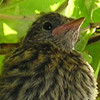I've been wanting to include a page about dunnocks for years, ever since I noticed how one of these humble grey-brown birds was sitting on the trellis archway by the back door many mornings in winter when I went out to replenish the bird table.
But dunnocks are, in general, quiet birds around the garden, and so unobtrusive that it's often hard to find them, never mind get close enough to take a photo.
A reference book I have suggests that the dunnock's song is rather tuneless, but I've always thought it clear and uplifting and certainly a cheerful kind of sound. When I first heard it, I was surprised that the small grey-brown dunnock, otherwise so timid, sang in such a lusty kind of way.
A bird of many names
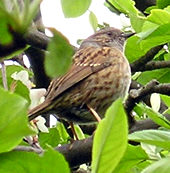
Many people call this bird the "Hedge Sparrow" - presumably because it's similar in colouring to a sparrow - being mainly brown and grey - and a similar size. The "hedge" bit must come from its habit of hanging around the bottoms of hedges looking for insects. Its proper scientific name is Prunella modularis. But it was introduced to me as the dunnock, and that's what I've always known it as. It was also pointed out to me that you could tell it from the sparrow straight away by its thin beak. It isn't related to sparrows at all.
The best name it has though is "shufflewing" - an old country name, as I discovered when researching on the internet. It is obviously inspired by the way the dunnock flicks (or shuffles) its wings while moving around quietly in the trees and hedges. The BTO Web BirdFacts page has more information, and includes another name - "Creepie".
It's one of my favourite garden birds. Its colouring is beautiful, in a subtle kind of way, and its mannerisms endearing. Apart from its wing-flicking movement, it is fond of sunbathing, and I've seen a dunnock sitting on the garden bench on a hot summer day, spreading out its wings and tail feathers to the sun. Perhaps all birds do this, but the only other time I've noticed this is with sunbathing blackbirds.
Dunnocks nesting, 2006
In the summer of 2006, the dunnocks nested on the wall near the kitchen, making the nest on top of a nesting box that is surrounded by climbing plants. The front part of the nest was quite visible, and I was worried about it also being visible to predators. This nest was a late one, in early July.
There have been lots of birds' nests in the garden over the years, as robins nested once, blue tits used the nestbox once, and blackbirds nest every year. From these experiences I know that just because a nest is made, it doesn't mean that eggs will be laid in it, and it doesn't mean that the eggs will then hatch, and it doesn't mean that if they do all the young birds will emerge, or that they'll survive. So I never have high expectations.
I think dunnocks have nested before, but they're so secretive and quiet it's been hard to follow the progress of any nest they've made. This one was easy to follow, being so close to the house.
If I stood on the edge of the old bath planter, a couple of metres from the nest, I could see it more clearly, without disturbing the birds. And after the eggs had hatched I could just make out the young bird's head. I could only see one - though there may have been more.
We were very protective of this late nest, and tried, as we usually do, to keep Rosie the cat away from it, and to keep her in when we could tell from the louder cheeping of the bird(s) in the nest that they were probably about to fly.
Dunnock emerges
When, one day, I heard some familiar cheeping in Kitchen Corner, away from the nest, I waited quietly to see where the adult dunnock went. I then discovered a tiny short-tailed juvenile dunnock, obviously just emerged into the world beyond its nest, trying to get its balance on the stem of a woody old ivy by the garden gate.
This tiny bird was, I think, the most perfect young bird I've ever seen in the garden, despite being just a brown and speckly thing.
Rosie was a bit disgruntled at being kept in, but it was obviously necessary to keep at least one predator at bay - while knowing full well that there would be many others - including other people's cats. I just hoped it would be safe long enough to get better orientated in terms of its flying, and that it would get itself higher up off the ground.
As indeed it did. I tried to locate it every day when I went out into the garden, and it was satisfying to see the way it was gradually moving higher up, so that after a few days it was in the foliage above the copper arch arbour, and later in several other locations above my head, as it had obviously mastered flying. On one of these occasions I managed, at last, to get a reasonably close photo - the one at the top of this page.
The things you find out
One of the best things about having birds and other wildlife in your garden is that it makes you investigate and find out things you'd have been totally unaware of otherwise. And this makes life in general more interesting, as you're going about your business.
For example, when I see a dunnock now, whether in my garden or anywhere else, I know that they don't pair up like most birds do, but that they tend to have less "traditional" arrangements. Dunnocks are - I wanted to call it "polyamorous", but I think in the bird world it's a different word. Or two. According to the helpful page on British Garden Birds - dunnocks are "polyandrous (females have more than one male mate) or polygynous (males have more than one female mate)".
So when our dunnocks nested on the wall in Kitchen Corner, I didn't know how many adults were feeding the young in the nest, how many "parents" there were. But I know that at least one young dunnock survived the crucial early phase, and that it was a beautiful little creature.
Though brightly-coloured birds are attractive, there's nothing wrong with brown and grey. Certainly in bird feathers, these colours are so varied that I could look at them happily for hours- if only the shufflewing would stay still long enough.
Links - further information
More information (and beautiful illustrations): Wild West Yorkshire Nature Diary - A Dance of Dunnocks and The Secret Life of the Dunnock, also from Wild West Yorkshire Nature Diary.
For more facts about the dunnock, see British Garden Birds: Dunnock.
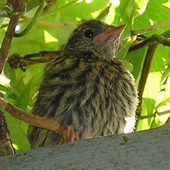
Above: A juvenile dunnock from a nest in the garden, 25 July 2006. At this stage it was still being fed by its parent(s).
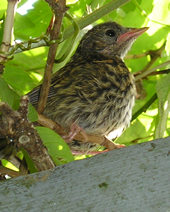
Above: Adult dunnock, 22 May 2006.
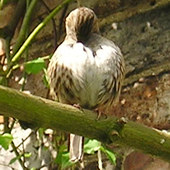
Above: Dunnock preening its feathers, 22 May 2006. From the paler breast feathers I think this is a juvenile bird too, maybe from an earlier nest.
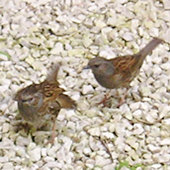
Above: Dunnock pair, in mid-April 2006, engaged in mating ritual. Apologies for the rather fuzzy picture. For an explanation of what's going on here, see Wild West Yorkshire Diary - A Dance of Dunnocks.)

